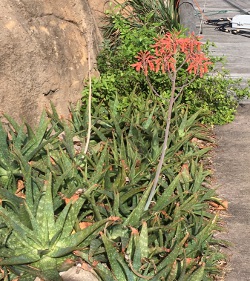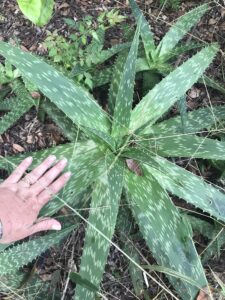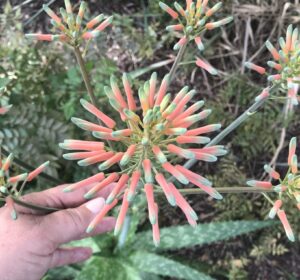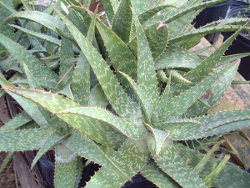S & J Nursery’s Guide to Growing
Soap Aloe
in the Northeast Florida
Landscape
( Aloe maculata / Aloe saponaria )
 Soap Aloe Origins:
Soap Aloe Origins:
As with so many of the hundreds of species of Aloe plants, Aloe maculata is native to South Africa. I first found this Aloe from a Florida grower being
grown with no botanical name attached as Wide Brim Aloe. I fell in love with the big fat specked leaves that unlike the Aloe vera plants I was familiar with this new Aloe stayed speckled with white as the leaves matured. The best part of this aloe plant for me is that it makes more of itself sending off pups surrounding the mother plant eventually forming a big round clump of Aloes. And who doesn’t like a garden plant that grows more garden plants for you? It’s like owning your very own ‘giving tree’.
Sun Exposure of Aloe maculata (Aloe saponaria) / Soap Aloe:
– Plant Soap Aloe in a full sun to a partially shaded location in the
Northeast Florida | Jacksonville | St. Augustine area landscape.
Foliage / Growth Habit and Height of the Aloe maculata  plant:
plant:
– Soap aloe grows into a mound of foliage that quickly reaches its maximum
height of just 1.5 ft and 2 ft wide with the blooms stalks rising to 3 ft mostly in summer and late
fall.
– Foliage of the Soap Aloe is marked with the characteristic double slashes
of vertical tiny white stripes giving the leaf a spotted look year round.
– Foliage can cold damage at 32 degrees and plants will recover quickly in
spring from any frost damage or discoloration that occurs during our Northeast Florida Jacksonville and St. Augustine landscapes. For me in my St. Johns county home garden only a slight discoloration occurs even in
the worst of winters and they seem to green back up with no extra fertilizer or trimming etc. in the spring.
Soil Preference / Salt tolerance of Soap Aloe / Aloe maculata:
– Drought tolerant once established into the landscape, Soap Aloe plants
make great xeroscape plantings and can be planted straight into Florida’s sandy soil without worry of amending the soil for it to hold water or nutrients.
– Avoid planting Aloe into areas of the landscape that hold water after our
frequent rains. If you don’t have the best drainage, consider planting your Aloe into a raised burm where the
roots will be up out of the wet zone during the rainier times of the year. You can also use them as a container planting and keep them in a decorative pot in the garden.
– Aloe plants are a great choice for the coastal areas of our Northeast Florida landscape and Soap Aloe is no exception as it makes a great seaside garden plant.
 Blooms of the Soap Aloe plant:
Blooms of the Soap Aloe plant:
– Butterfly and hummingbird attracting, winter flower spikes rise high above the foliage and are a beautiful coral orange color.
– Soap aloe for me blooms mostly in the summer and fall -winter but is said to be able to bloom intermittently year round.
Water Requirements:
– Although much more durable once established in the landscape, regular water is necessary to get the plant rooted and growing on its own after being planted in the ground from an S & J Tree Farm and Nursery container. Water once to twice a week for the first few weeks after planting.
Care of Soap Aloe in the Northeast Florida /  Jacksonville and St. Augustine area garden:
Jacksonville and St. Augustine area garden:
– Low care landscape pant selection.
– Water once to twice a week during the establishment period after planting in the garden from an S & J Tree Farm and Nursery container. After the establishment period the Soap Aloe plant can be left to grow on its own in the ground or in a decorative container.
– Aloe plants will prefer areas with excellent drainage, avoid water logged
soils or areas that drain slowly after a rain.
– Fertilize each spring with a shovel full of good garden compost or a slow
release poly coated plant food such as Osmocote or Stay Green general
purpose plant food or 10-10-10.

